
People are the biggest driver of performance. That’s why business leaders need the right digital marketing team structure in place. In this article, we explore the essential roles within a digital marketing team, how teams can be structured, the agency-client relationship, and key ingredients for high-performing teams.
Essential roles within a digital marketing team structure
First, let’s take a look at the roles that make up a digital marketing team. It should be noted that there may be other more specialized roles on a team, but the below represents the most common.
Digital Marketing Director
This role understands how all digital channels work together to align with the customer journey. They strategize and lead specialists, creatives, and web developers on digital marketing initiatives. Typically reports up to a VP Marketing, CMO, or in some instances a CRO.
Creative Strategist
This role is a bridge between analytics, market research, graphic design and copywriters. These strategists use analytics and market research to influence direction of ad copy and imagery.
Media Manager
This role would manage and optimize ad spend across channels such as Google, Facebook, LinkedIn, and more.
Content Marketing Manager
These managers work with content production resources to develop media and thought leadership, such as blog posts, podcasts, or downloadable PDFs.
SEO Specialist
This specialized role reviews existing web pages for optimizations, researches new opportunities to grow organic search traffic.
Social Media Specialist
This role can have many different focus areas, based on platform (Facebook, LinkedIn, Snapchat, etc.) and whether the strategy calls for an emphasis on organic or paid.
Email & Marketing Automation
Sometimes this role has titles like “Revenue Operations” or “Marketing Operations” They are responsible for communicating with users who opt in to receive emails and managing automated workflows.
Analytics Specialist
This role ensures proper tracking, data collection and reporting on digital marketing campaigns. They are adept at quantitative analysis of datasets from sources like Google Analytics, your CRM, and ad platforms.
Graphic Designer
These roles create visual elements for a wide range of digital marketing channels and campaigns, including web pages, blog headers, social tiles, display ads, and more.
Copywriter
This role writes copy tailored to specific platforms and ad types, which have different character counts and best practices. Copywriters must also have a firm grasp on the subject matter they write about.
Web Developer
These technical specialists use code, such as HTML, Javascript, and Python, to create web pages and other digital assets.
Marketing team structures evolve
Marketing org charts come in all shapes and sizes, depending on your industry or the stage of your company’s growth. Your digital marketing team may not need all of the above specialists, but it will likely need some combination.
Let’s use a software-as-a-service (SaaS) company that sells to other businesses (B2B) as an example. Keep in mind the key specialist roles needed for a digital marketing campaign, but also the headcount constraints of a growing business.
B2B SaaS Org Chart: ~6 Employees
Before an initial investment, one founder may head up the entire sales and marketing function, possibly supported by a full-time marketer who acts as a generalist. Or, they specialize in one or a few of the disciplines listed above. An org chart might look like this:
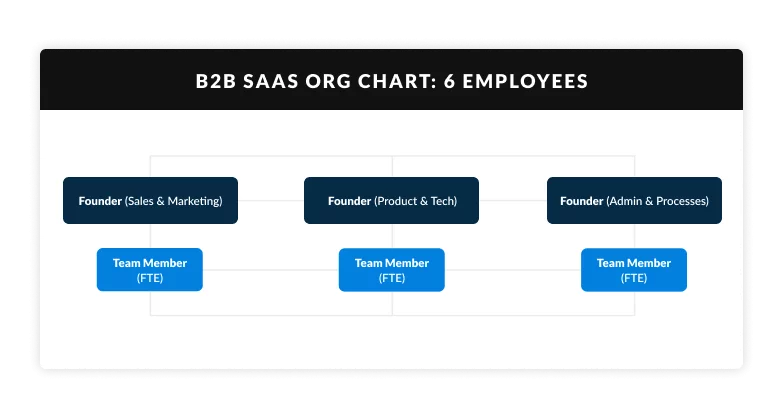
B2B SaaS Org Chart: ~50 Employees
At 50 employees, many businesses today (especially SaaS companies) have consolidated sales and marketing into one “revenue” function. In these organizations, VP of Sales, Marketing and Customer Success might report into a Chief Revenue Officer (CRO). A VP of Marketing may have its own small team 2-3 full-time specialists, supported by one or multiple agencies. An org chart might look like this, with the “revenue” function highlighted in blue:
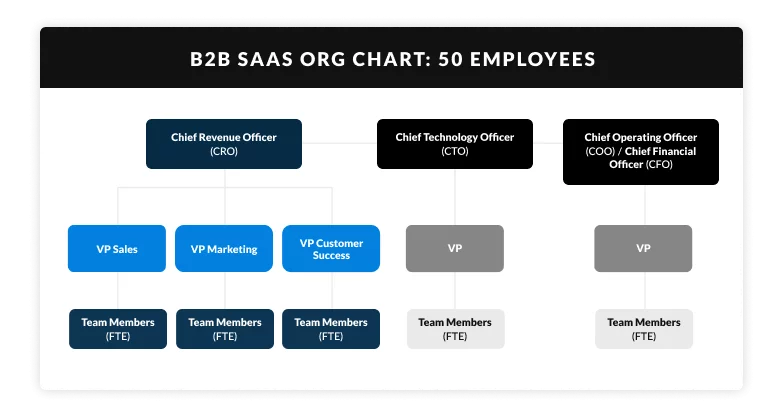
B2B SaaS Org Chart: ~125 Employees
As the company grows to 125 employees or more, a VP of Marketing may have a team of 3-4 specialists designated to focus on one or two digital channels. These specialists report to a Marketing Director and work together to develop and implement integrated marketing strategies.
Unless the company has in-house content creators, graphic designers and web developers, much of the work may still need to be outsourced to digital agencies and/or freelancers e.g. for content writing, graphic design, web development projects. The org chart might look something like this:
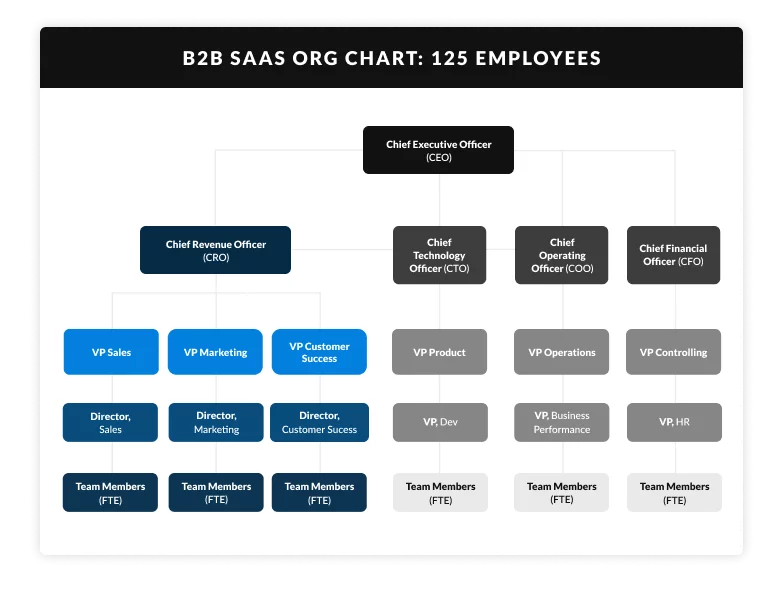
Beware of silos in your digital marketing team structure
The example above shows how most organizations start out with a flat structure. As they build out their functions, the natural tendency is to group employees with similar skill sets into departments. This creates highly skilled specialists who get work done more efficiently. It’s common for key individual contributors to grow into people managers under this structure.
The downside is this setup can create silos, which may stifle collaboration and innovation across other departments. This friction can make it hard for each department to align with the organizational vision. Recently, I joined a panel discussion to share how Silverback is working to break down these silos to go from departments to “Troops.” Listen to the webinar here.
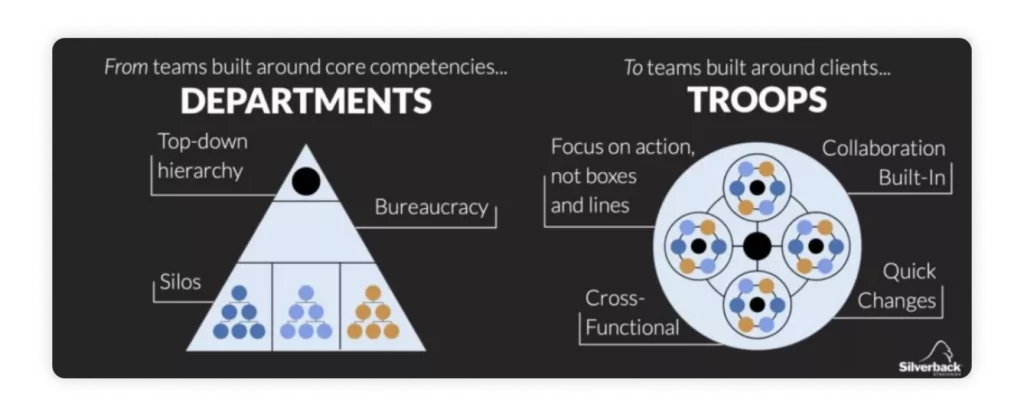
In-house vs outsourced marketing: a delicate balance
According to Maslow’s hierarchy of needs, once an individual’s physiological needs are satisfied, the needs for security and safety become salient. People want to experience order, predictability and control in their lives.
The same phenomenon is true in business. Marketing leaders are under pressure to deliver consistent profit growth. But so many variables are outside of their control. Sometimes, deciding which activities to bring in-house vs outsource comes down to the kind of risk a business is willing to tolerate, and what gives them the most control over achieving their goals.
Striking the right balance depends on many factors, like a company’s industry, strategy, and finances. On one end of the spectrum, companies can insource 100% of their marketing. On the other end, they could outsource all of their marketing to an agency. Most companies lie somewhere in the middle.
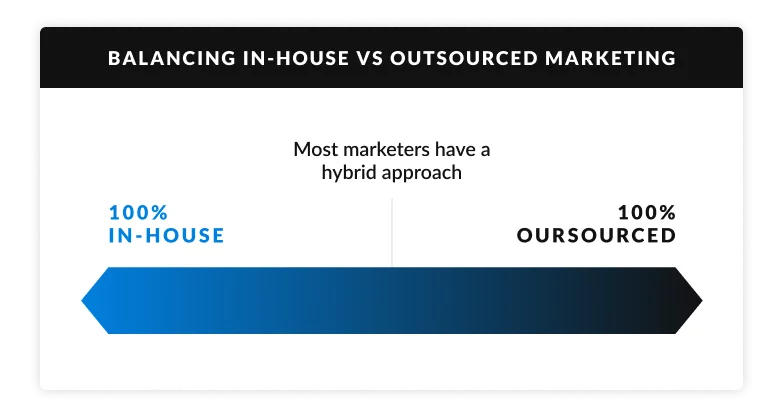
Possibly the most important factor, though, is the marketing talent you already have on staff. There is limited availability for specialists. Your current digital marketing team structure can be a roadmap to which activities you need to outsource. For example, let’s say you have someone with killer copywriting skills, but isn’t up to speed on SEO best practices. You can build around that key skill by outsourcing an Editorial SEO program to help that written content rank in search results.
Benefits of working with a digital marketing agency
During growth periods, businesses need to keep headcount low. This is a major reason why many small to mid-sized businesses work with a digital marketing agency. It gives them the flexibility they need to find the right people to bring in-house, or it can be a way to quickly ramp up leads and sales without investing in learning and development.
There are other benefits of working with a digital marketing agency. The Society of Digital Agencies found companies desire two main things from their agency partner: 1) marketing creativity and 2) product/service innovation. Let’s take a closer look at each.
Marketing creativity
Marketing creativity is the practice of trying something new to market your existing product or service. It could be a series of structured tests to measure the impact of marketing messages or channels. For instance, we ran an experiment with AAFMAA to measure the impact of radio advertising on website sessions. Read the full case study or watch the video here.
Agencies can be a good source of marketing creativity by drawing from institutional knowledge and shared expertise. In healthy agencies, marketers share insights, test results and experiences with each-other. This creates an environment where successful tests can be applied to other client accounts who may benefit. Marketers learn more quickly what works and how to operate platforms and channels. This collective expertise can have an impact across an agency’s entire client portfolio.
Product/service innovation
Product or service innovation happens when you try something new to meet buyer demand. Working with agencies can accelerate innovation with customer insights. Brands and agencies are able to work together to develop a product or service prototype. Then, agencies can help test product-market fit with structured tests.
Not any agency can help with marketing creativity or product/service innovation. The key ingredient to unlocking these benefits is a good working relationship. Let’s take a closer look at how agencies and clients work together.
The agency-client relationship
According to the American Association of Advertising Agencies, the average length of agency-client relationship in 1997 was 5.7 years. Today, that average has shrunk to 3.3. This is most likely because attribution and analytics can more quickly show when marketing investments fail to deliver.
Fortunately, the rise of analytics has also made it easier to see what does work. Finding an agency that delivers results and fits well with your internal team can have an incredible impact. There are three possible ways to set up a digital marketing team structure with an agency:
- One-to-many. This is when one agency representative works with many different points of contact within a client’s company.
- Many-to-one. This is when many agency representatives work with one point of contact within a client’s company.
- Collaborative. This is when, at various times depending on the project, different agency representatives work with different points of contact within a client’s company.
See the illustration below for visuals of each.
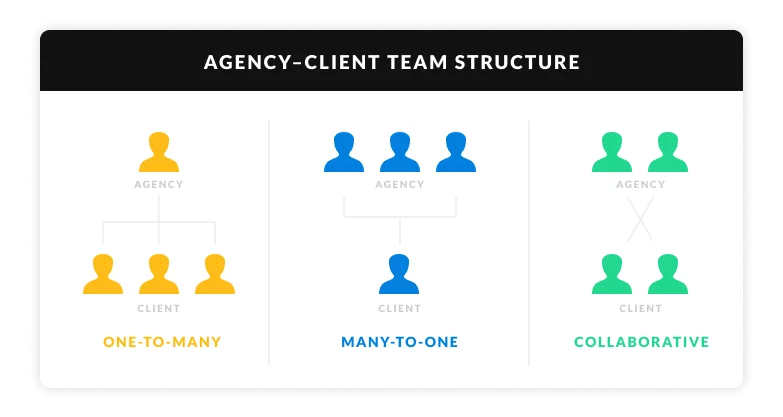
At Silverback, we work with clients in many different ways. We’ve found the most success when a collaborative arrangement (illustrated above) matches strategic and tactical resources appropriately between a client and an agency. For instance, a CMO probably doesn’t need to regularly interface with an SEO specialist. This configuration helps align objectives, strategy, and tactics in order to meet clients’ business goals. We’ll explore more details about this team structure later in this article.
Team diversity, personality and communicating effectively
The cultural and ethnic diversity within your digital marketing team structure is important. At the end of the day, marketing teams are made up of people with various backgrounds, personalities, and behavioral traits. According to Deloitte, more high-growth brands measure diversity, equity, and inclusion (DEI) initiatives in their brand messaging and imagery (38%) than talent retention (33%) or hiring objectives (23%). These findings suggest an intellectually and culturally diverse team is more likely to produce high-performance marketing campaigns.
At Silverback, we also use a tool called the Predictive Index to evaluate the personality traits of our employees. This helped us build high-performance teams by placing employees on teams compatible with their personality profile. Each team, depending on the profiles of its members, has a team personality. According to Predictive Index, an “exploring” team is risk-tolerant, able to innovate quickly and try new things. “Cultivating” teams are better suited to execute on more collaborative work, supporting each-other and coming to consensus.
Healthy teams also communicate effectively. On our Digital Marketing Troop podcast, author, speaker and consultant Tim Parkin shares how companies can build their marketing teams from the inside-out by focusing on effective communication. Listen to the full episode here:
Working with multiple boutique agencies
There are benefits to working with multiple agencies. You get access to specialists who can help you with a particular channel like search or social, or perhaps there is a creative agency whose work aligns well with your brand.
The illustration below is an example of a digital marketing team structure where one manager is responsible for working with multiple agencies.
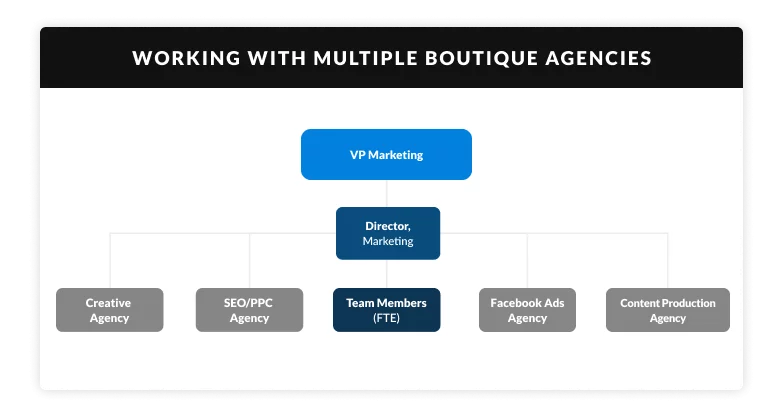
The downside to this team structure is each relationship needs to be managed. Coordinating multiple boutique agencies can be overwhelming. In our experience, when clients try to do this, they often miss the mark on getting these teams to collaborate to the extent that they should. With this many cooks in the kitchen, it’s unlikely they’re all aligned on what’s best for the client.
Working with an integrated performance marketing agency
Fifteen years ago, Silverback Strategies started out as a boutique PPC agency. Since then we have grown into an integrated performance marketing agency with more than 70 employees. This growth is due to deep focus studying how people work together. We’ve developed a digital marketing team structure that flexes with the changing needs of our clients. Search, social, content and analytics work in-sync with content and creative teams for seamless, holistic marketing campaigns. See the illustration below.
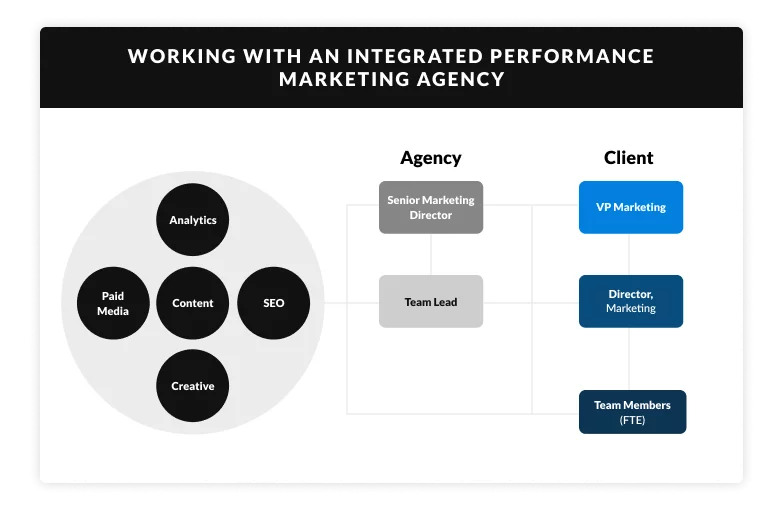
AdAge, Inc. Magazine and Washington Post have recognized Silverback Strategies as a top place to work in the United States. Our secret is simple. Healthy teams lead to happy employees and happy clients. Silverback’s focus on team health leads to open, honest and direct communication between clients and staff alike. This means we can solve issues faster, set clear expectations, and deliver impressive results.
If you want to learn how we can set up the right digital marketing team structure for you, contact us today.
Recent Posts
Creative Strategy in Digital Advertising
Read the ArticleEthical Considerations of AI In Marketing: Balancing Innovation with Responsibility
Read the ArticleTop-Down vs. Bottom-Up Budgeting: Which Should You Use?
Read the Article
Unlock Your Growth Potential
Silverback helps businesses catapult web traffic, leads, and sales. We combine analytical and creative expertise to drive inbound marketing campaigns and track it all to find insights on what worked, what didn’t, and what we should try out next.
Contact Us